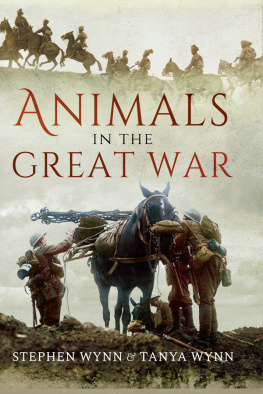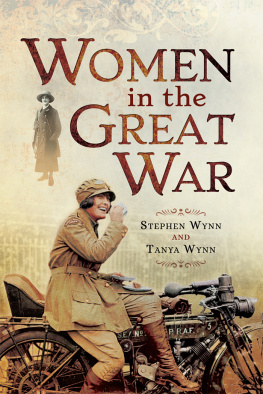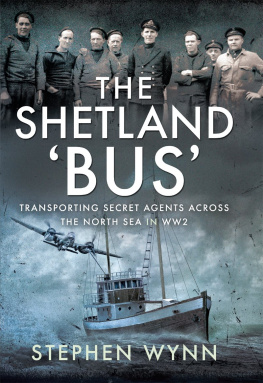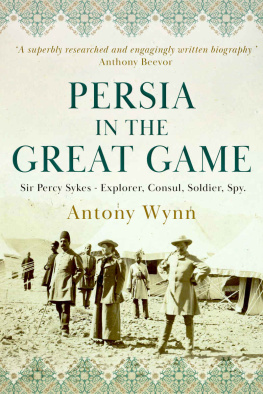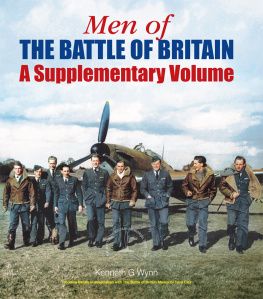ANIMALS IN THE GREAT WAR
ANIMALS IN THE GREAT WAR
STEPHEN WYNN AND TANYA WYNN
First published in Great Britain in 2019 by
PEN AND SWORD MILITARY
An imprint of
Pen & Sword Books Ltd
Yorkshire Philadelphia
Copyright Stephen Wynn and Tanya Wynn, 2019
ISBN 978 1 47383 804 8
eISBN 978 1 47386 553 2
Mobi ISBN 978 1 47386 552 5
The right of Stephen Wynn and Tanya Wynn to be identified as Authors of this work has been asserted by them in accordance with the Copyright, Designs and Patents Act 1988.
A CIP catalogue record for this book is available from the British Library.
All rights reserved. No part of this book may be reproduced or transmitted in any form or by any means, electronic or mechanical including photocopying, recording or by any information storage and retrieval system, without permission from the Publisher in writing.
Pen & Sword Books Limited incorporates the imprints of Atlas, Archaeology, Aviation, Discovery, Family History, Fiction, History, Maritime, Military, Military Classics, Politics, Select, Transport, True Crime, Air World, Frontline Publishing, Leo Cooper, Remember When, Seaforth Publishing, The Praetorian Press, Wharncliffe Local History, Wharncliffe Transport, Wharncliffe True Crime and White Owl.
For a complete list of Pen & Sword titles please contact
PEN & SWORD BOOKS LIMITED
47 Church Street, Barnsley, South Yorkshire, S70 2AS, England
E-mail:
Website: www.pen-and-sword.co.uk
Or
PEN AND SWORD BOOKS
1950 Lawrence Rd, Havertown, PA 19083, USA
E-mail:
Website: www.penandswordbooks.com
Foreword
Seeing as this is a book on animals, we are going to be somewhat self-indulgent and mention the three cats, eight guinea-pigs and nine dogs that have been companions throughout the course of our lives.
Special mention goes to one of our German Shepherds, Dexter. When we began writing this book, he was already undergoing chemotherapy for blood cancer after having had his spleen removed. As a result of the operation and four sessions of chemotherapy, he had twelve weeks of additional, quality life, which provided us with many great memories. He had a sudden relapse, and sadly passed away at 8.30am on Tuesday, 17 July 2018. His passing was painful, but he will remain in our hearts and memories forever more.
Introduction
Animals and war have gone hand in hand for thousands of years. The earliest evidence of horses being used in warfare dates back to Eurasia, sometime between 4000 and 3000 BC. The years between 1600 and 1350 BC saw the use of horse drawn chariots throughout the area which roughly covers what is known as the Middle East today.
The earliest use of saddles on horses, or what then passed for saddles, can be traced to around 700 BC by Assyrian cavalry.
In about 360 BC, the skills required to be able to ride a horse in combat were written about by a Greek cavalry officer, by the name of Xenophon.
The story of the Carthaginian Hannibals epic crossing of the Pyrenees and the Alps in the year 218 BC, with men, horses and elephants, on his way to fight the Romans during the Second Punic War, has been told and retold a thousand times. People still marvel at his sheer temerity at even having considered doing what he did.
The middle of the nineteenth century saw the Charge of the Light Brigade, which took place at Balaklava on 25 October 1854, during the Crimean War. The charge, which was part of the Siege of Sevastopol, was led by Lord Cardigan against Russian forces, when just over 600 troopers of the Light Brigade charged into the valley between the Fedyukhin Heights and the Causeway Heights. By the end of the charge, 110 of the troopers had been killed, with a further 161 wounded.
By the First World War, cavalry were almost obsolete and probably would have been entirely, if it hadnt been for the large number of senior officers who had started out as cavalry officers in the initial years of their military service. There were many cavalry charges during the First World War, there was even one on the very last day of the war at Levinnes in Belgium, though the reason why is not at all clear. One of the most notable cavalry charges took place two weeks into the Battle of the Somme, on 14 July 1916, on the outskirts of the village of Bazentin le Petit.
An area known to the British as High Wood and to the Germans as the Bois des Fourreaux , was fought over by British and German forces over the course of 14 and 15 July. Its name has changed slightly, and is today known as the Bois des Fourcaux .
There were many different types of animals used in the First World War, horses certainly werent the only ones that were used. Donkeys and asses were used to convey artillery pieces, ammunition and other equipment to and from the front line. Dogs, cats and pigeons were employed for different military purposes, and others, such as a springbok of the 4th South African Regiment, were used as mascots.
Chapter 1
Pigeons
The homing pigeon is a domestic bird found all across the United Kingdom, with the ability to travel extremely long distances to find its way back home. It is able to do this by using magnetoreception, which according to Wikipedia is:
A sense which allows an organism to detect a magnetic field to perceive direction, altitude or location. This sensory modality is used by a range of animals for orientation and navigation, and as a method for animals to develop regional maps, for the purpose of navigation.
Soldiers preparing to release messenger pigeon.
Over the relatively short distance for a pigeon of say, 400 miles, they could quite comfortably maintain a good average speed in the vicinity of 50 miles per hour.
Unlike humans, who have front-facing eyes, pigeons have monocular vision, which means they have to move their heads each time they take a step, to be able to maintain their depth of perception. In essence, a pigeon can see and focus on something that is a static, rather than a moving object.
The use of pigeons as messengers can be traced back to Persia and Syria in around the 5th century BC. Over the following centuries the practice of sending messages by pigeon between towns and cities, as a means of communication, was developed all over the area which is today known as the Middle East. It was like an early postal system. The Romans were another civilisation who used pigeons to communicate with different realms of their Empire.
News of the outcome of the Battle of Waterloo was first received back in England by means of a messenger pigeon, so widespread was their use as a way of communication.




